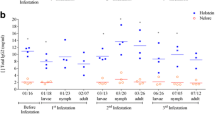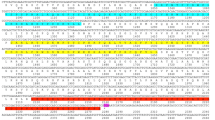Abstract
A monoclonal antibody directed against a paralysis toxin of Rhipicephalus evertsi evertsi ticks was used to localize the toxin in cytoplasmic granules and, surprisingly, chromatin of the nuclei of cells which resemble the “b” cell type in the salivary glands of Rhipicephalus appendiculatus, Boophilus microplus and Ixodes holocyclus. The association of toxin with chromatin indicates that the toxin may have a regulatory function. Evidence is provided to support the view that the toxin is made up of three identical sub-units, with only the trimeric form being toxic.
Similar content being viewed by others
References
Bell G. H., 1959. Experimental physiology, 6th edn John Smith and Sons, Glasgow.
Binnington K. C., 1978. Sequential changes in salivary gland structure during attachment and feeding of the cattle tick, Boophilus microplus. International Journal for Parasitology, 8: 97–115.
Binnington K. C. and Stone B. F., 1981. Developmental changes in morphology and toxin content of the salivary gland of the Australian paralysis tick Ixodes holocyclus. International Journal of Parasitology, 11: 343–351.
Binnington K. C., Young A. S. and Obenchain F. D., 1983. Morphology of normal and Theileria parva infected salivary glands of Rhipicephalus appendiculatus. Journal of Parasitology, 9: 421–424.
Crause J. C., Verschoor J. A., Burger D. B. and Neitz A. W. H., 1991. Preparation of monoclonal antibodies against salivary gland immunogens of female Rhipicephalus evertsi evertsi, Experimental and Applied Acarology, 13: 75–80.
Fourie L. J., Horak I. G. and Van Zyl J. M., 1991. Sites of attachment and intraspecific infestation densities of the brown paralysis tick (Rhipicephalus punctatus) on Angora goats. Experimental and Applied Acarology. 12: 243–249.
Gothe R., 1984. Tick paralysis: Reasons for appearing during ixodid and argasid feeding. In: Current topics in vector research., Vol. 2 (ed. Harris K. F.), pp. 199–223. New York: Praeger Publishers.
Gothe R. and Lämmler M., 1982. Zur sektoralen Einordnung der Toxizität im Repletionsporozess Paralyse-induzierender weiblicher Rhipicephalus evertsi evertsi-paralyse. Zentralblatt für Veterinärmedizin B., 29: 249–252.
Gothe R. and Neitz A. W. H., 1991. Tick paralysis: Pathogenesis and Etiology. In: Advances in Disease Vector Research., Vol. 8 (ed. Harris K. F.), pp. 177–204. New York: Springer-Verlag Inc.
Harris D. T., 1947. The contractile tissues. In: Experimental physiology for medical students, 4th edn. J. and A. Churchill, London.
Laemmli U. K., 1970. Cleavage of structural proteins during the assembly of the head of Bacteriophage T4. Nature, 227: 680–685.
Mackenzie H. A. and Dawson R. M. C., 1969. pH, buffers and physiological media. In: Data for biochemical research, 2nd edn. (ed. Dawson R. M. C., Elliott D. C. W. H., Elliott W. H. & Jones K. M.), pp. 507–508. Oxford: Oxford University Press.
Stone B. F. and Binnington K. C., 1986. The paralyzing toxin and other immunogens of the tick I. holocyclus and the role of the salivary gland in their biosyntheses. In: Morphology, Physiology and Behavioral Biology of Ticks (ed. Sauer J. R. and Hair J. A.), pp. 75–99. Chichester, Ellis Horwood.
Stone B. F., Binnington K. C., Gauci M and Aylward J. H., 1989. Tick/Host Interactions for Ixodes holocyclus: Role, Effects, Biosynthesis and Nature of its Toxic and Allergenic Oral Secretions. Experimental and Applied Acarology, 7: 59–69.
Viljoen, G. J., 1985. Isolation and characterization of tick toxins. Ph.D-thesis. pp 1–191. Pretoria: University of Pretoria.
Viljoen, G. J., Bezuidenhout, J. D., Oberem, P. T., Vermeulen, N. M. J.
Visser L., Gothe R. and Neitz A. W. H., 1986. Isolation of a neurotoxin from the salivary glands of female Rhipicephalus evertsi evertsi. The Journal of Parasitology, 72: 865–874.
Author information
Authors and Affiliations
Rights and permissions
About this article
Cite this article
Crause, J.C., Verschoor, J.A., Coetzee, J. et al. The localization of a paralysis toxin in granules and nuclei of prefed female Rhipicephalus evertsi evertsi tick salivary gland cells. Exp Appl Acarol 17, 357–363 (1993). https://doi.org/10.1007/BF00058598
Accepted:
Issue Date:
DOI: https://doi.org/10.1007/BF00058598




